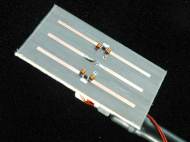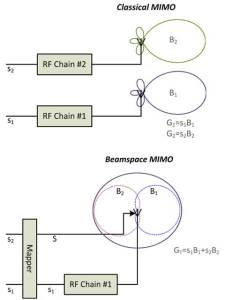Beamspace MIMO – two mobile communication antennas in one
 Unlike researchers from Rice University who repurposed MIMO (multiple-input, multiple outputs) antenna technology, researchers at EPFL decided to develop Beamspace MIMO – a system where a single antenna can be used to transmitting the same data as the two-antenna MIMO system. This achievement will be more than useful for future communication systems, since it is less costly and easier to integrate into hardware.
Unlike researchers from Rice University who repurposed MIMO (multiple-input, multiple outputs) antenna technology, researchers at EPFL decided to develop Beamspace MIMO – a system where a single antenna can be used to transmitting the same data as the two-antenna MIMO system. This achievement will be more than useful for future communication systems, since it is less costly and easier to integrate into hardware.
Current MIMO antenna technology uses several antennas to transmit and receive signals. Since it is becoming more widely used in devices such as wireless modems and next-gen mobile phones, the need for more speed and bandwidth leads to increased energy consumption and emission power. The antennas have to be placed at a certain distance from each other, making the process where this technology is used in already packed devices a challenge. Each separate transmitting antenna must have its own encoding and amplifying signal device, which is requires more resources to be produced and energy to operate.
In collaboration with researchers from Athens Information Technology (AIT), the researchers from EPFL achieved first ever experimental demonstration of the Beamspace MIMO concept. Beamspace MIMO maps independent datastreams onto an orthogonal set of basis functions in the antenna far-field. This novel approach uses a single RF chain and uses single compact antenna which manages to simultaneously emit two information flows.
Only one coding and amplifying device is required to treat the first information flow, while the second signal is treated only upstream and then used to make the radiation pattern decomposable. The latter signal acts therefore both as an information carrier and as a mean to decompose the principal pattern.
“This technique allows us to get rid of part of the usual hardware”, said Julien Perruisseau-Carrier, who leads the group for Adaptive MicroNano Wave Systems at EPFL. “This work required us to look at both antennas, particularly reconfigurable ones, and radio coding. Although they are closely linked, these two disciplines are unfortunately often considered separately, which hinders this kind of innovative work. One of the biggest challenges is to ensure that each pattern is really independent, to allow an efficient treatment of the information.”
Perruisseau-Carrier and his doctoral student Moshen Yousefbeiki are now focusing on a new antenna prototype that will be much more compact and suitable for use in small mobile devices, such as cell phones, as well as miniature antennas that can be implanted for medical purposes.
For more information, read the paper published in the journal IEEE Transactions on Antennas and Propagation: “MIMO Transmission using a Single RF Source: Theory and Antenna Design“.










author
Part of the new findings will be presented by Julien Perruisseau-Carrier, at the IEEE International Symposium on Antennas and Propagation and USNC/URSI National Radio Science Meeting, Chicago, IL, USA, July 8-13, 2012.
Thanks Damir for this article. I found it very helpful in that it summarizes the topic in very simple terms in a nutshell.